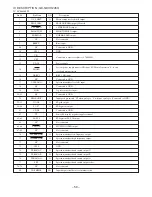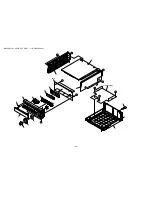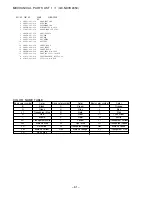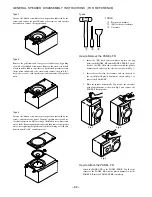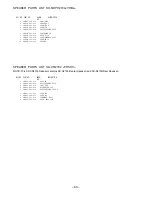
– 48 –
ADJUSTMENT <DECK> (FX-NDVH2450)
< DECK SECTION >
1. Tape Speed Adjustment (Normal)
Settings :
• Test tape :
TTA–100 (Tape center)
• Test point :
TP1 (Rch), TP2 (Lch)
• Adjustment location : SFR1
Method :
Play back the test tape and adjust SFR1 so that
the test point becomes 3000Hz
±
5Hz(FWD)
Then check REV speed is 3000Hz
±
45Hz.
2. Tape Speed Check (High)
Settings :
• Test tape :
TTA–100 (Tape center)
• Test point :
TP1 (Rch), TP2 (Lch)
Method :
After normal speed adjustment, play back
the test tape and check that the high
speed is 6000Hz
±
400Hz (FWD).
3. Head Azimuth Adjustment
Settings :
• Test tape :
TTA–300
• Test point :
TP1(Rch), TP2 (Lch)
• Adjustment location : Head azimuth
adjustment screw
Method :
Play back the 10kHz signal of the test tape and
adjust screw so that the output becomes
maximum. Next, perform on each FWD PLAY
and REV PLAY mode.
4
PB Sensitivity Adjustment (DECK1, DECK2)
Settings :
• Test tape :
TTA–200
• Test point :
TP1 (Rch), TP2 (Lch)
• Adjustment location : SFR301 (DECK1, Lch)
SFR302 (DECK1, Rch)
SFR303 (DECK2, Lch)
SFR304 (DECK2, Rch)
Method :
Play back the test tape and adjust SFRs so that
the output level at the test point becomes
245mV (DECK2), 260mV (DECK1).
5. PB Frequency Response Check (DECK1, DECK2)
Settings :
• Test tape :
TTA–300
• Test point :
TP1 (Rch), TP2 (Lch)
Method :
Play back the 315Hz and 10kHz signals of the
test tape and check that the output ratio of the
10kHz signal with respect to that of the 315Hz
signal is 0dB .
Next, check that the Lch and Rch difference
level of 10kHz signal is less than 2dB.
6. REC/PB Sensitivity Adjustment (DECK2)
Settings :
• Test tape :
TTA–602 (NORMAL)
• Test point :
TP1 (Rch), TP2 (Lch)
• Input signal :
1kHz (LINE IN)
• Adjustment location : SFR305 (Lch)
SFR306 (Rch)
Method :
Apply a 1kHz signal and REC mode. Then adjust
OSC attenuator so that the output level at the
TP1, TP2 becomes 0dB (17mV). Record and
play back the 1kHz signals and adjust SFRs so
that the output is 0dB
±
0.5dB.
7. REC/PB Frequency Response Adjustment (DECK2)
Settings :
• Test tape :
TTA–602 (NORMAL)
• Test point :
TP2 (Lch), TP1 (Rch)
• Input signal :
1kHz / 10kHz
(LINE IN)
• Adjustment location : SFR351 (Lch)
SFR352 (Rch)
Method :
Apply a 1kHz signal and REC mode. Then adjust
OSC attenuator so that the output level at the
TP1, TP2 becomes 0dB (17mV). Record and
play back the 1kHz and 10kHz signals and adjust
SFRs so that the output level of the 10kHz
signals becomes 0dB
±
0.5dB with respect to
that of the 1kHz signal.
Summary of Contents for XR-DVH2450
Page 13: ... 13 SCHEMATIC DIAGRAM 1 MAIN VM CONN 10P MX NDVH2450 ...
Page 15: ... 15 SCHEMATIC DIAGRAM 2 FRONT MX NDVH2450 ...
Page 17: ... 17 SCHEMATIC DIAGRAM 3 TUNER MX NDVH2450 ...
Page 19: ... 19 SCHEMATIC DIAGRAM 4 AC1 SUB TRANS AC2 AC1 SW MX NDVH2450 ...
Page 21: ... 21 SCHEMATIC DIAGRAM 5 PRO LOGIC MX NDVH2450 ...
Page 23: ... 23 IC BLOCK DIAGRAM MX NDVH2450 IC NJM2152M ...
Page 24: ... 24 ...
Page 33: ... 33 SCHEMATIC DIAGRAM MAIN FRONT KEY CONN DX NDVH2450 ...
Page 43: ... 43 SCHEMATIC DIAGRAM MAIN FRONT 1 FRONT 2 DECK HEAD 1 HEAD 2 FX NDVH2450 ...
Page 45: ... 45 IC BLOCK DIAGRAM FX NDVH2450 ...
Page 54: ... 54 TRANSISTOR ILLUSTRATION GE NDVH2450 E B C RN1410 ...
Page 56: ... 56 SCHEMATIC DIAGRAM MAIN GE NDVH2450 ...


























